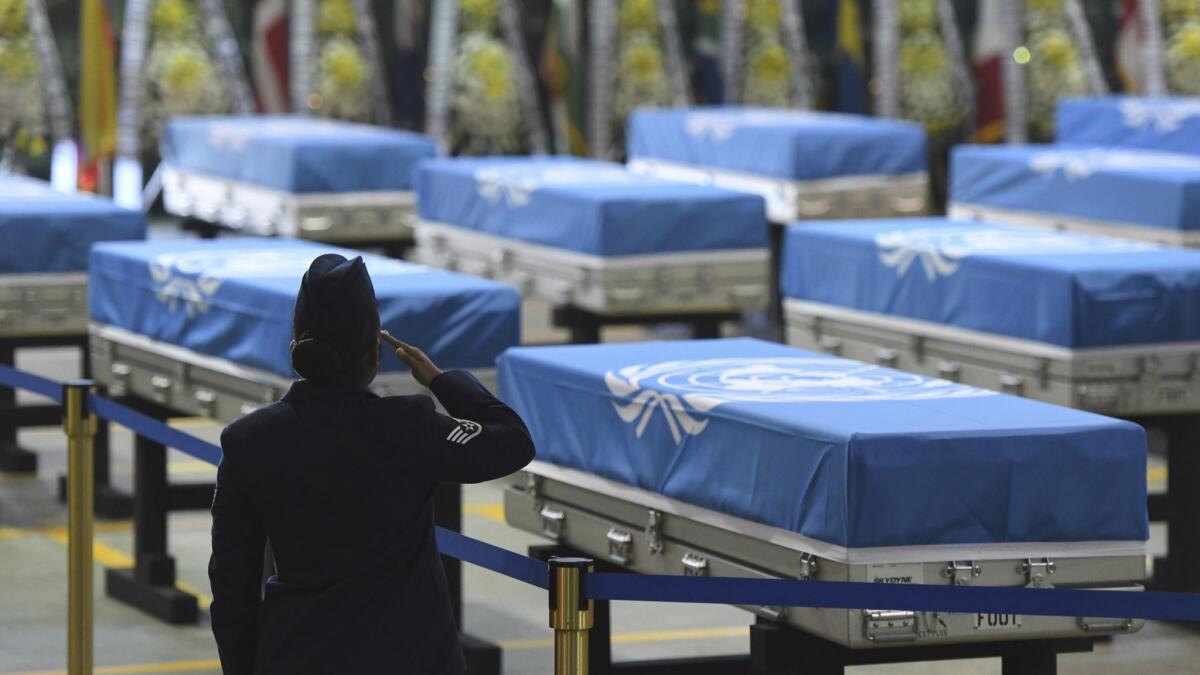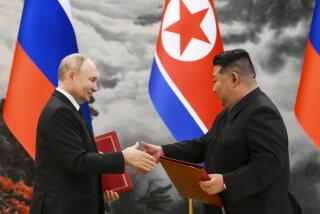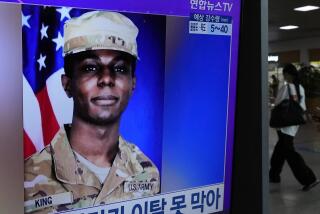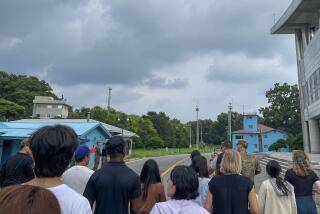U.S. prepares to send home presumed Korean War remains handed over by North Korea

- Share via
Reporting from OSAN AIR BASE, South Korea — More than 60 years after the last shot in the Korean War, the U.S. military prepared to fly home Wednesday what are believed to be the remains of more than 50 servicemen after the first such handover by North Korea in more than a decade.
The remains were transferred by North Korea last week, the first tangible moves from agreements reached between President Trump and North Korean leader Kim Jong Un at their meeting in Singapore on June 12.
After a solemn ceremony at the U.S. military’s Osan Air Base in South Korea, 55 boxes of remains draped in the United Nations flag were taken to a U.S. military plane, which will then take them to a military laboratory in Hawaii for further analysis and identification.
Initial forensic analysis suggested the remains were likely to be of American servicemen, the U.S. military said. But experts say positive identification of all the remains could take years.
“Generally speaking, what I can tell you is that the remains are consistent with the remains we have recovered in North Korea,” John Byrd, director of analysis for the U.S. Defense POW/MIA Accounting Agency, told a news conference before the ceremony.
Byrd said the preliminary findings of the American investigation were that the remains are what North Korean officials said they were.
“They are likely to be American remains,” he said.
The North Koreans provided enough information about where each body was found to allow U.S. officials to match them to battles fought between 1950 and 1951, Byrd said.
One dog tag was returned and the family of that soldier has been informed, but it has not been established if his remains were among those returned, Byrd said.
Indeed, North Korean military officials did not claim that every item in each box went together, he said.
“They expressed concern that there was a lot of co-mingling when these remains were recovered from the very beginning,” he said. “We do hope that the individual [with the] dog tag is somewhere among these remains we’ve taken back, and we will certainly be very aggressive in trying to run that to ground.”
Byrd said there was also a lot of military hardware, such as helmets, canteens and boots, included in the shipment.
The Pentagon estimates that nearly 7,700 U.S. troops are unaccounted for from the war; among them are 5,300 believed to have been killed north of the 38th parallel, which largely follows the boundary between North and South Korea. Most died on the battlefield and were buried in shallow graves or in cemeteries that were intended to be temporary, but some also perished in POW camps run by North Korea or China, experts say.
The process of finding and repatriating their remains has long been hampered by North Korea’s reluctance to allow U.S. military investigators unrestricted access to battle sites, and to wring political capital and money out of the process of returning the remains.
Troops from 16 other nations also fought alongside the Americans under a U.N. flag during the Korean War, and diplomats and officials from all those countries placed wreaths at the ceremony. Defense Secretary James N. Mattis said last week that it was possible some of the remains could have come from those nations, and if so, they would be repatriated once they have been identified.
Trump last week again thanked North Korea’s Kim for returning the remains. On Wednesday, U.S. Consul General Angela Kerwin said Wednesday that no money was paid to North Korea for the remains.
The remains were first flown from the North Korean city of Wonsan last Friday, on the 65th anniversary of the armistice, and were greeted at Osan Air Base by hundreds of U.S. service personnel and their families.
Another ceremony was conducted to send them on their way to Hawaii on Wednesday, with bugles playing taps as well as the Last Post, a call used at funerals by British and Commonwealth militaries, and a South Korean bugle call. National anthems of the United States and South Korea were played, and the caskets were given a 21-gun salute by U.S. riflemen.
Secretary of State Michael R. Pompeo said last month that the two sides had agreed to recommence field operations in North Korea to search for the missing Americans, and the Pentagon says it is considering sending personnel to North Korea for this purpose.
The United States and North Korea militaries conducted joint searches for missing servicemen from 1996 until 2005, with 400 caskets of remains handed over during this period.
But Washington then halted the program, citing concerns about the safety of its personnel as Pyongyang stepped up its nuclear program. The U.S. says it does not pay directly for the remains but has given the North Koreans “compensation” for the costs of the recovery in the past.
More to Read
Sign up for Essential California
The most important California stories and recommendations in your inbox every morning.
You may occasionally receive promotional content from the Los Angeles Times.










